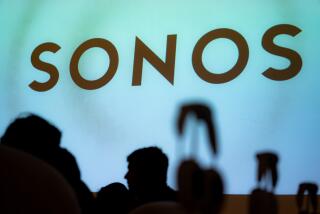Rio Making a Play to Regain Dominance in Portable Music
- Share via
It took Rio Audio just three weeks this spring to go into bankruptcy protection, cut its ties to floundering former owner Sonicblue Inc. and emerge as part of Tokyo’s D&M; Holdings Inc.
Now, the Santa Clara, Calif.-based maker of portable digital music players is spending the next three weeks replacing its entire product line in a bold bid to regain the dominance it squandered during Sonicblue’s financial troubles.
The company has a long way to go. Once the leading name in pocket-size MP3 players, which store music on computer memory chips, Rio saw its share of the market shrink from about 40% at its peak to about 15% today, President Jeff Hastings said.
The decline came as demand for MP3 players started to heat up. Manufacturers’ sales of MP3 players to dealers were stuck at or below $100 million from 1999 to 2001, according to the Consumer Electronics Assn., but steadily declining prices caused demand to more than double in 2002 and sales to rise to an estimated $178 million.
Sonicblue’s financial problems were a major factor in Rio’s slide, Hastings said. Sonicblue, which filed for U.S. Bankruptcy Court protection in March, couldn’t pay its suppliers enough to keep stores stocked with its products, which included ReplayTV digital video recorders and Rio MP3 players.
D&M; bought Sonicblue’s Rio and ReplayTV units at a bankruptcy auction in April for $18.2 million and $18 million, respectively, and established them as separate business units under its Digital Networks North America subsidiary.
The market for chip-based players had shrunk in the face of two new lines of MP3 products: portable CD players that could handle discs filled with MP3 songs, and palm-sized players with hard drives that could store 100 times as many songs as the top-selling Rio models.
Rio then responded on both fronts, offering a hard-drive-equipped model and a line of CD-based MP3 players. Those efforts, however, proved to be failures.
Hastings said the company was dropping out of the portable CD business, which he said accounted for 40% to 45% of the market for MP3 players.
“The CD market is extremely unprofitable now,” he said, adding that it was hard for manufacturers to differentiate their products.
The company also is replacing its bulky hard-drive player with a smaller and lighter 20- gigabyte model, dubbed Karma, that’s shorter but thicker than Apple Computer Inc.’s acclaimed iPod. And it’s breaking ground with an even smaller player, dubbed Nitrus, that uses the new slender 1.5-gigabyte hard drive from Cornice Inc.
Analysts expect Cornice drives to power a new and potentially profitable niche in the MP3 market: devices that combine the portability of chip-based players with the capacity of hard-drive models, with prices that fall between the two.
Although hard-drive-based players have created most of the buzz in the industry, in large part because of Apple’s marketing of the iPod, they represent only 10% to 15% of the market, Hastings said. That’s why Rio expects most of its profit to continue coming from chip-based players.
With that in mind, Rio is trying to breathe new life into its chip-based players with slicker designs and better software, including the ability to load the players automatically with a new set of songs whenever they are connected to a computer.
Hastings, who was vice president of engineering at Sonicblue, said D&M; had kept a restructured Rio team in place, although with fewer people and a tighter focus.
“The first thing is profitability,” Hastings said. “If you lose money, there’s a bad outcome at the end of it, no matter how good it sounds in the short term.”





